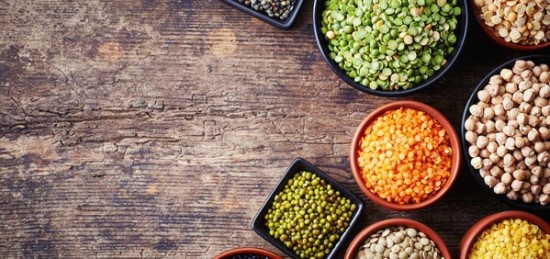By Leslie Bonci, MPH, RD, CSSD, LDN
To make sure we get enough protein everyday, it is important to consider quality and quantity. When we think of protein, the first foods that come to mind are typically chicken, beef and maybe eggs. But what if you opt to get your protein from plants instead of animal sources? A diet rich in vegetables, whole grains, beans, soy foods, and nuts and seeds can provide enough protein.
And the Dietary Guidelines for 2015-2020 recommend a plant-based eating plan as one of the dietary patterns to choose.[1]
Animal Protein & Plant Protein
Amino acids are the building blocks of protein, and protein quality is determined by its amino acid composition. There are 9 essential amino acids, meaning our bodies cannot make them and we must get them from dietary sources.
Animal sources of protein -- meat, poultry, fish, eggs, dairy –contain all of the essential amino acids, which makes them complete proteins. Plant proteins are considered incomplete because they do not have all of the essentials. But plant-based foods like legumes (including beans and peanuts), nuts, seeds, grains and vegetables still have varying amounts of protein.
PLANT-BASED PROTEIN
| Whole wheat toast, 2 slices | 6 grams |
| Broccoli, 1 cup | 4 grams |
| Brown rice, 1 cup | 5 grams |
| Beans, ½ cup | 7-9 grams |
| Lentils, ½ cup | 9 grams |
| Peanuts, 1/3 cup | 11 grams |
| Peanut butter, 2 Tbsp | 9 grams |
| Oats, ½ cup dry | 5 grams |
| Chia seeds, 2 Tbsp | 6 grams |
| Spinach, cooked-½ cup | 3 grams |
And there is a myth that plant-based foods cannot provide the same benefits as animal proteins because they are incomplete. It is a fact that most plant proteins cannot make new protein for basic body functions because they are incomplete. However, you will not necessarily be in a protein or amino acid deficit if you eat primarily plant-based protein.
In fact, it’s as easy as making a peanut butter and jelly sandwich! By combining complementary proteins -- grains, like rice or bread, and plant-based protein sources, like peanuts, peanut butter or beans – you create a complete protein.
Even so, eating grains and plant protein together is not necessary at every meal or snacktime. The body creates protein over a 24-hour period, NOT everytime you chow down. In other words, as long as the complementary proteins are eaten within the same day, the body accepts them as complete proteins [2].
For instance, you might decide to grab whole grain toast and jam at breakfast, but then have a handful of peanuts as a mid-morning snack. Even though you did not eat the grains and legumes together, your body can synthesize new protein over the course of the day.
But if you ate your toast with peanut butter, it would be a complete protein, meaning all essential amino acids are delivered within one meal. Other examples are corn tortillas with black beans, bean soup and crackers, rice and lentils, and wheat noodles with peanuts and/or peanut sauce.
To learn more about what the research says about plant-based protein, click here.
Learn more about your protein needs here.
And here are some ideas for 20 gram protein meals and 10 gram protein snacks:
20-gram Protein Breakfasts
#1- 2 TBSP peanut butter and jelly sandwich on whole grain bread with an 8 ounce glass of soy milk
#2: Tofu scramble made with 3 ounces soft tofu, ½ cup of spinach, and 2 slices of whole wheat bread
#3: An 8-inch whole wheat wrap with ½ cup chickpeas, ½ of an avocado, 2 TBSP shredded cheese and 2 TBSP salsa
20-gram Protein Lunches
#1: Black bean burger, lettuce, tomato, on a whole wheat bun with ½ cup baby carrots
#2: Salad of leafy greens, with ½ cup kidney beans, 2 TBSP peanuts, ½ cup brown rice , & an apple
#3: Pasta salad-Bean based pasta-1 cup with ½ cup of mixed vegetables, 2 TBSP edamame hummus
20-gram Protein Dinners
#1- 1 cup lentils with ½ cup rice, ½ cup tomatoes, 2 TBSP peanuts and ½ cup broccoli
#2- Stir-fry of 4 oz tofu, with 1.5 c Asian vegetables, served with 1 c soba noodles
#3: ½ of an acorn squash stuffed with a mixture on onions, ½ cup quinoa, 1/3 cup sunflower seeds
7/8-gram Protein snacks
- ¼ cup of peanuts
- 8 ounce glass of peanut or soy milk
- 1-2 tablespoons peanut butter
- ¼ cup hummus with vegetables
References
[1] U.S. Department of Health and Human Services and U.S. Department of Agriculture. 2015 – 2020 Dietary Guidelines for Americans. 8th Edition. December 2015. Available at https://health.gov/our-work/food-nutrition/previous-dietary-guidelines/2015.
[2]“Interactive Nutrition Facts Label - Protein.” Food and Drug Administration,www.accessdata.fda.gov/scripts/interactivenutritionfactslabel/protein.cfm.
